This site is full of awesome and amazing post. I see something only to lose it when I want to go back to it. I’m going to post random thoughts that you can read or add to the post.
Announcement
Collapse
Step One For New Members
If you are reading this, you are in the main forum....where all the good discussion and exchange of ideas occurs.
Instructional threads are 'stickied' to the top of this forum page in an effort to get new members to see the work that gets done here. There are 5 different threads of a dad and his kid, going through the HittingIllustrated process. They are quite instructional. I think you'll be impressed with what you see. The kid's progress is amazing. One of them is now a D1 player who chose college after being drafted. Another is a DII college player. A third is his brother who is now in high school. The fourth is a current high school freshman. And the fifth is my son who is now out of college and playing amateur fastpitch softball. Take a look. The terminology is likely to confuse you at first. But do your best to understand.
Then, there is another forum titled The Second Engine, found just below this one on the main page, which consists of 18 threads that have been chosen as 'good reads' for new members to get 'up to snuff' on what is taught here.
It is my recommendation that you spend your first hour or so in that forum reading those threads. Then, come here to ask questions. We love it when clips of hitters are posted.
And here is a link to an Instructional Starter Pak. It has the basic information. There are many details that go with each step that are too cumbersome to put in the Pak.
Instructional Starter Pak
If I were you, I'd concentrate on figuring out what the Hand Pivot Point and what the Rear Hip Pivot Point are....and how they are synced together to create the high level swing.
Welcome.
Instructional threads are 'stickied' to the top of this forum page in an effort to get new members to see the work that gets done here. There are 5 different threads of a dad and his kid, going through the HittingIllustrated process. They are quite instructional. I think you'll be impressed with what you see. The kid's progress is amazing. One of them is now a D1 player who chose college after being drafted. Another is a DII college player. A third is his brother who is now in high school. The fourth is a current high school freshman. And the fifth is my son who is now out of college and playing amateur fastpitch softball. Take a look. The terminology is likely to confuse you at first. But do your best to understand.
Then, there is another forum titled The Second Engine, found just below this one on the main page, which consists of 18 threads that have been chosen as 'good reads' for new members to get 'up to snuff' on what is taught here.
It is my recommendation that you spend your first hour or so in that forum reading those threads. Then, come here to ask questions. We love it when clips of hitters are posted.
And here is a link to an Instructional Starter Pak. It has the basic information. There are many details that go with each step that are too cumbersome to put in the Pak.
Instructional Starter Pak
MAKE THE BEST USE OF YOUR TRIAL PERIOD
POST A CLIP OF YOUR SON OR DAUGHTER
I'LL GIVE YOU AN ANALYSIS AND A RECOMMENDATION.
POST A CLIP OF YOUR SON OR DAUGHTER
I'LL GIVE YOU AN ANALYSIS AND A RECOMMENDATION.
If I were you, I'd concentrate on figuring out what the Hand Pivot Point and what the Rear Hip Pivot Point are....and how they are synced together to create the high level swing.
Welcome.
See more
See less
Random but great post
Collapse
This topic is closed.
X
X
-
The scap
The swing has so many movements that depend on other parts of the swing to be high level. This to me is one of those.Originally posted by Teacherman View PostIn my opinion it is the scap action.....not the hands. Meaning...the hands allow it to happen as the scap action takes place.
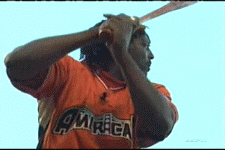
If the hands are doing the untipping....then they bleed some of their power....and it isn't all there to turn the barrel at go. And it's difficult to start the hands to untip....then go with them....two moves.....resistance is lost making it less efficient.
In conjunction with recent posts regarding what most call the scap loading actually being the beginning of the launch.....here is a clip that I believe shows some important points.
[IMG]http://www.teachersbilliards.com/Brndn072607a2.gif[/IMG
The most important point being HOW the swivel.....HOW the hand pivot point .....is created.
The second being....a point we talked about recently....The goal should not be to swing.....at least while you're learning......the goal for a new student HAS to be getting to the launch position and getting there on time.Last edited by Mike; 08-31-2018, 09:48 AM.
-
More on the scapOriginally posted by Mike View PostThe scap
Originally posted by Teacherman View PostIt happens at go. The scap/spine junction is tight. The scap resists. The spine bursts through the resistance. Another way of saying the scap never stops pulling back. The spine bursting through the scap is done by the rear leg winning the SnF battle. As the leg turns, it turns the fused torso. The turning fused torso meets strong resistance from the scap. Scap does not surrender. It gets beaten by the spine.
The swing has so many movements that depend on other parts of the swing to be high level. This to me is one of those.
Comment
-
Here a key to using your back. Richard mentions using the insider bat , a great tool.
Originally posted by Teacherman View PostI just had an incredible workout with my oldest son.
A very revealing 30-40 minutes.....was his inability to do this....
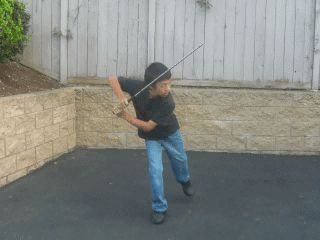
....but more so, his use of the word "can't"....as in...."I can't do that".
I explained to him that I was using my back to balance myself....and to swing....and to stay balanced after the swing.
He is quite athletic.
He said 'can't'....but saw me doing it.
He realized it was a balance issue.
He really struggled with it.
Swing after swing it wasn't there.
Then I put the Insider Bat in his hands....which took some weight/stress off of him....and suddenly he started snapping it through....from one leg....without losing balance.
And suddenly....his light bulb went on. He finally realized what it means to swing with your back. If you're constantly falling forward or sideways....while swinging....doesn't it stand to reason that you need more 'backward' force to counter it.
Yep....he finally went from his chest to his back.
I can not say enough about the one-legged drill.
I'm not certain there is any better way to find what you have to find.
This is what you're looking for....
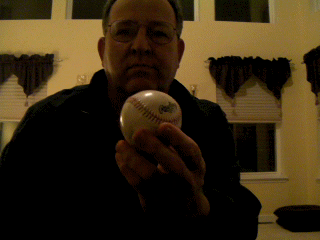
But there is a certain group of muscles that you must learn to use. Back muscles.
As a thought....that I'm thinking about right now after the lesson....that I've never said before is....those muscles of the back....they balance you....and swing. Same muscles. You don't balance with the back but swing with the chest. You balance with the back and swing with the back. The balancing part 'turns them on'.....so to speak.
it is an absolute shame that mightylakers didn't insist that littlelakers proceed and learn to swing with the muscles he is using in this drill.
Tonight I saw an athletic kid tell me no.
He told me he couldn't do it.....as if he was made differently.
But I could do it.
So he kept trying.
And then the light bulb went on.
I've always liked the drill.
I really like it now.
I highly recommend it.
I am also here to tell you.....that most kids use a bat that is too heavy for their back at the moment.
Comment
-
The importance of the lateral tilt
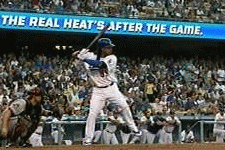
http://www.hittingillustrated.com/library/Manny26.gif
Originally posted by HYP View PostThe flattening of the hands?
The turning of the hands/forearms, rotating of the triangle and tilting of the shoulders?
The lateral tilt
Originally posted by Teacherman View PostYep.
All three are important. But I get a feeling the shoulder lateral tilt is misunderstood.
Recently I've seen swings that appear to be 'in the ball park'. Yet they aren't exposive. They aren't sudden.
In those swings the shoulder lateral tilt almost appears to be a separate move.
It is literally the lead shoulder going straight up....and the rear shoulder going straight down....which is 'smoothed out' in video....and misinterpreted because of the turning of the hips. That turning 'rounds off' the look.
But the feel is what is important. It feels like your back is flat up against a wall and you have to swing while leaving it flat against the wall. Again....that is the feel. Reality is the hips are turning everything. So the look is different. But that is the feel to be created.
I see swings that appear to be a partial lateral tilt followed by a turning. A turning not generated by the hip turn...but a redirecting of the shoulders....from lateral to around the spine. By the shoulders.
The lateral tilt is a launch and spend move. It is an 'all in' move. It is all or nothing. It is the lead shoulder straight up....rear shoulder straight down.....all at once....and very sudden.
Done correctly this projects the hips forward....it shifts them forward into the overlap.
Can you 'feel' what Manny feels? It feels like there is a spike right through his sternum....roughtly horizontal to the ground....and his shoulders/torso rotate about that spike.
But there is no spike. So....how about this.....it is a lateral bend of the spine. Which is WAY more explosive and sudden than rotation around that spine.
It is as sudden as a twitch. And a reason kids have trouble getting it is it is directed away from the ball. The rear shoulder going down...and the hands going down....so that the barrel can turn upward through the zone.....is NOT what 99.99% of them do. 99.99% of them take the hands forward in some fashion or another. And this forward hand movement is accompanied by a forward turn of the rear shoulder. A turn of the rear shoulder initially toward the plate....'around the shoulders'.....and then toward the pitcher....as they continue to rotate around the shoulders.
The lateral tilt is an aggressive....explosive.....sudden.....'all in'.....all or nothing.....launch and spend.....downward move....of the rear shoulder....with your back held against a wall 'feel'.
Therefore.....I'm going to say it.....again.....and again and again and again......THERE IS NO TILT TOWARD THE PLATE IN A HIGH LEVEL SWING.
The tilt over the plate that 'they' see.....is the 'turned' lateral shoulder tilt. What they see is the lateral shoulder tilt AFTER the hip turn....and claim the hitter maintained his tilt through contact. Hogwash.
They say the hitter started tilted over the plate. But, I would say....no they didn't....instead they 'sat'.....either in their stance (Pujols)....or they moved there during their load (Bonds)....and that 'sit' includes some bend at the waist for balance.
BUT......rather than argue that......lets argue what can be proven.
What can be proven is how the bow (tilt over the plate....forward bend at the waist) must turn to arch (arch of the back) to free the rear hip.
In other words.....to hit.....you HAVE to come out of your initial bend.

Notice how a high level pitcher bows at the waist....and then arches his back....and what happens at that time?.....at the time of the arch......separation. The rear hip is given the freedom to perform by the 'coming out of the tilt'.
And here is what is interesting.....and another PCR misread. While bowed.......I call it sit with balance.....they call it tilt over the plate that must be maintained through contact.....the rear leg is pushing....and pushing hard.....with little to no movement.....isometic if you will....because of the torso's 'hold' by leaning over. And then....when the upper body gives up the 'hold'.....gives up the tilt.....and arches the lower back......when the shoulders laterally tilt......there is a suddenness to the push of the rear leg. The resistance is gone. The rear hip fires up and through.
Show me a PCR hitters whose rear hip goes up and through. It doesn't exist. Their rear hip is trapped. They don't push with the rear leg. They don't use resisitance to get any sudden launch.Last edited by Mike; 09-03-2018, 08:23 AM.
Comment
-
Fused torso and lateral tilt
Richard originally asked "Why does this drill work?"
Originally posted by Teacherman View Post
Because it removes the HOLDING OF THE BAT from his arms. His arms have NOTHING to do. They have nothing they have to do to get the job done.
Most kids have always swung with their arms. Therefore, in their stance, in their setup, the bat is HELD BY THE ARMS. It is held by the arms because their current swing NEEDS the arms to work. It is held by the arms in such a way so that the arms are activated immediately. And even though their activation is immediate, they can not produce an immediate, sudden swing. They work in a way that they have to move forward to produce any momentum. This forward move takes time and is simply unusable in the batters box. I know. I did it all my life.
What the clip above teaches is how to get the body to do the work. It takes the arms out of the equation. The bat is HELD BY THE BODY. It's weight is supported by the body. You simply 'work' your rear hip socket and you will learn how to get all the way to contact with JUST body movement. Then, you should be able to 'feel' how a simple wrist flick is all that is necessary to finish the puzzle. A rearward wrist flick, swiveled, enhances the stretch and finishes the swing.
It really is not that hard to do. I suspect many have done it, but passed on it because it didn't feel like they were working hard enough. You see, you want the BARREL to feel the speed.....not the body. When you try to make your body feel like it is fast and working hard the barrel is dragging. Keep the body quiet, let the energy go to the barrel.
A SnF release does not feel like work. It is short and sudden. The body feels very quiet when you compare it to an arm swing. The head feels very still.
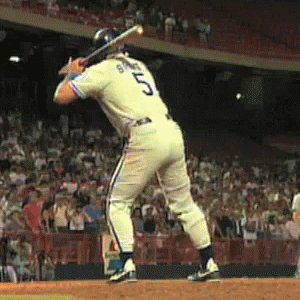
Comment
-
more on fused torso and lateral tilt
Originally posted by Al Oha View PostWhen a "coil of a coil" gets released you get a dimensional release at two levels within the same axis since both coils have their origin in the rear leg. The leg becomes the driver in the genesis of a compound whip in SnF.
See Post #4: http://hittingillustrated.com/forum/...drive-and-more
I might also add that I believe the lateral tilt is the product of a dynamic process created by active "coiling of the coil", rather than one consciously produced to simply get the elbow through during the uptick.
See Post #5: http://hittingillustrated.com/forum/...ing-Mini-Pronk
If I may add to what Teach may be suggesting...
It appears that Matt's lateral tilt is a passive bend towards the pitcher, hence a shift, rather than a penetrating rag wring that grabs the fascia, the "white stuff" that attaches the muscle to bone (lats to the rear pelvic bone) in the lowest portion of the back in the creation of optimal lateral tilt.
Comment
-
A you tube video of Richard explaining load around and counter rotation
https://youtu.be/03VoDJfJTl4
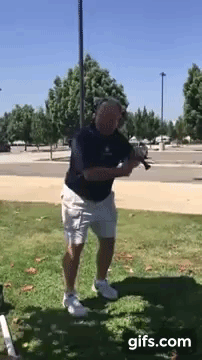
putting more of it together
Originally posted by Teacherman View PostIMO, the largest difference between 'load around' and 'counterrotation', is turning the barrel v pulling the knob. The difference is applying force perp to the handle v down it's length.
When you pull the knob, and counterrotate, you are lengthening the swing. Because the barrel doesn't arc to the ball until the hands, which are moved further back by the counterrotation, get out front to their 'end of the rope' destination. So, with counterrotation, you are lengthening that distance from start to arc.
When you turn the barrel, and 'load around', which resembles counterrotation, the hands do not have to travel at all before the barrel will arc.....because the hands are turning the barrel from the armpit/shoulder tip at the gitgo. They may travel....depending on pitch location and timing.....but if they do....the barrel is already arcing. The 'load around', is simply more stretch. It has nothing to do with increasing the distance before which the barrel can arc.....because the barrel will arc immediately from whatever amount of 'load around' or 'counterrotation' that a given hitter has.
And, when the initial angle of attack of the barrel, is toward the opposite field, on every swing, regardless of location, with the hands/shoulders resisting the forward turn of the rear hip, it leads to even more stretch. Which is a good thing. And if the barrel direction needs to be changed, to 'down central' or 'inside', the body is capable of 'turning a little'....in the rear hip joint.....to allow bat ball alignment for the given pitch....WITHOUT BLEEDING THE STRETCH....because as it does that, the hands/shoulders are still resisting.
THIS IS BIG.
Counterrotation of a knob puller lengthens their swing. Loading around, (I use a different term for the same thing so as to distinquish the difference between them) does not lengthen the swing. The hands will turn the barrel from whatever direction the 'load around' has taken them to....and is easily adjusted without bleeding the load....and without forcing early commitment.
THIS IS BIG.Last edited by Mike; 09-03-2018, 12:19 PM.
Comment
-
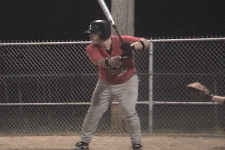
A Little Somethin Somethin....
....for the lurkers coming to HittingIllustrated.com....
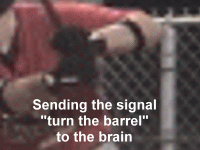
This is a closeup taken from this swing....
The clip says...."the body begins it's prep"....to accomplish the goal of 'turning the barrel".
There are 4 Major Checkpoints the 'body' must accomplish and accomplish in order....to properly 'prep' for the upcoming goal....which is 'turn the barrel'.
Checkpoint #1: Quality rear hip socket separation. A quality coil. The rear hip coiling rearward AGAINST a rear leg that is INTERNALLY rotating. Movement JUST in the hip socket. Leg is firm. Femur is firm. Rock solid. Hip turns about the ball of the femur. This action is felt MOSTLY in the glute and the inner thigh of the rear leg.
Checkpoint #2: Tight lower back muscles just above the rear hip....the latissimus dorsi (I think....and others?) pulling the torso rearward....against the resisting INTERNALLY rotating rear leg.
http://en.wikipedia.org/wiki/Latissimus_dorsi_muscle
Checkpoint #3: A 'pinched and clamped down' scap. The Rhomboids pulling the scap toward the spine and holding it there. It must be held....not released....until after the corner. When you pinch the scap....you should feel movement in your rear leg....you should feel a pull against the rear leg. If you don't....a checkpoint is missing. Something between is not tight.
http://en.wikipedia.org/wiki/Rhomboid_muscles
Checkpoint #4: Upward/rearward pressure on the handle by the top hand prior to go....during the pitch read. When you pull a little harder....like a test....you should feel it tug against your rear leg. That pressure is never released....never redirected....THAT pressure IS the beginnnig of the launch. Rearward. Rearward. Rearward. Did I say rearward? It tells the body what you are going to do with all of this stretching.....and from where you are going to do it.
When all has been accomplished....in order....you are left with the hands stretched against the rear leg. Rear side resistance.
When the hands turn the barrel....the 'go' move....all resistance is released.....the rear leg defeats the hip and the lat and the scap and the barrel is yanked....whipped....into autopilot.
Stretch n Fire.
A wave. A sequence. A spiral of energy upward, so to speak. Starts in the hip socket....spirals upward.
You anatomists.....feel free to correct my muscle names. Or add to them.
P.S. This swing resulted in one of the longest HR's ever hit in this ball park. This was his 5th or 6th HR of the season. Summer '07. Had never hit a HR before in his life.
Notice the external rotation of the rear foot (not the leg...the leg is contantly internally rotating)....caused by the coil.
.Last edited by Mike; 09-05-2018, 11:23 AM.
Comment
-
The Evolution Of The Swivel
EVOLUTION OF THE SWIVEL
HOW DID THEY LEARN TO SWIVEL SINCE IT WASN'T TAUGHT TO THEM
LEAD ARM PULL.....BACK ARM PUSH.....BOTH.....ROTATION.....CONNECTION.....SEPA RATION.....RUNNING START.....WEIGHT SHIFT.....OVERLAP
If you're like me, and have studied video extensively, and have been around the game a long time, an interesting subject always comes up when explaining the high level pattern. How did the high level hitters learn to do what they do? It is clear that most weren't taught the high level pattern. So how did they get to where they are today. And more specifically, I'm going to concentrate on the swivel. The turning of the barrel rearward at "go".
The following is just a theory. It may follow your experience. It may not. Feel free to add your thoughts below. I am by no means offering this as proof of how it developed. This would fall in my "best guess" category.
Let's start with 10-12 year old kids. There appears to be three categories. THE NATURAL, who unknowingly used his body right the first time he picked up a bat, had success and because of that success (and no one coached him out of it) he continued using the high level pattern. We won't concern ourselves with the natural.
The other two categories include the LEAD ARM PULLER, who does just what it says. And the REAR ARM PUSHER, again, who does just what it says. The choice may have to do with their dominant hand, although that doesn't explain a righty thrower who bats left and vice versa.
The Puller is not usually a stong upper body kid. He may have some success at the lower levels but as he goes up the playing ladder, he quickly realizes his bat is dragging. He's too slow.
The Pusher is usually a strong upper body kid. He may also have success at lower levels but soon realizes he pushes himself out of the zone and can't make consistent solid contact. He's too quick.
At that level of play, both kids might just hit the crap out of the ball but suffer from inconsistency. Pitching is not doing it to them. They are doing it to themselves.
So from that starting point, the first need is consistency and the first evolution step is the COMBO. You combine the two. The puller adds the push. The pusher adds the pull. The puller has less pull but substitutes more push. The pusher has less push but substitutes more pull. You end up with the push/pull, somewhere near 50/50 each. The pull, mostly by the lead arm, of both hands forward, combined with the push into contact, by the "hammering motion" (not a swivel) of the top hand, late in the swing. The Combo could also be called the BM. We know this is disconnection. Just an arm swing. But the hitter isn't being taxed physically yet and gets by with it.
This works well for awhile. But as they approach high school, that pitching just gets faster and faster AND they are now changing speeds and breaking pitches off. The hitter has a sudden need for adjustability. Both in handling speeds and handling locations. His need changes from consistency to adjustability. He may or may not consciously know this, but the body says "if I was quicker, I could wait longer, and make better decisions". So, the hitter works on his body mechanics. He works at ROTATION. Using the hips better. Even lifting weights. Trying to increase his body's quickness. The problem is, good hip rotation with disconnection is a band aid. He gets some mileage out of it but he soon learns that won't cut it.
Next he evolves into CONNECTION. Trying to make sure that the new energy found in the new and improved hip rotation reaches the barrel. It's probably found by trial and error. Maybe by emulation. But this step reverses the push/pull step. You can't do both and have success. You can't have connection and disconnection. So, he's quicker, as a result of the new hip rotation, but he has to become a lead arm puller, to maintain connection, in order to deliver the body's energy to the barrel. The push of the push/pull has to go. So....a dilemma. He's quicker. But he's lost his adjustability. He can hit the crap out of a ball that he's "on", but he just can't get "on" often enough. He faces two options. Drag it. Or pull off.
Some where around this time, in his dealing with his problem, he learns SEPARATION of the upper and lower body. Maybe he "gets it" from his throwing. Maybe he just trial and errs long enough and stumbles onto it. But the separation leads to a new level of quickness. The new level of launch quickness helps immensely. But, that pitching, man, it just keeps getting faster and faster. It is REALLY fast now. No matter how quick he is from "go", he just can't get there consistently. And, that adjustability is still an issue.
So, he thinks he needs to get going sooner. He needs a RUNNING START. He needs to start without starting. He needs to start without yet committing. So, through trial and error, he learns to "carry forward". He learns to develop some momentum. This helps a lot. He has already broken inertia and now can swing when he needs to.
But, that pitching. How good can they get?
So, through more trial and error and/or emulation, he learns to WEIGHT SHIFT into 'go'. He already has the momentum of a running start. Now he suddenly energizes the swing by the sudden shift of weight from back to front at "go". A rear leg action. A rear leg push. He comes out of a knee bend. He feels it. He says "this is good". And he learns about that last little bit of stretch he gets as the weight shifts suddenly. This last little bit of stretch happens AS the hands are going rearward. Ala Jeff Kent. The separation has moved from just the upper body versus lower body, to the hands versus the hips. This is his first "feel" of two pivot points. The barrel begins to float rearward as he works on this weight shift. As he works on the two pivot points. As he learns to prepare to make it happen that barrel begins to float.
Suddenly, he "feels" the OVERLAP. He feels how the two pivot points work together to create one move. He feels the benefit of weight back then shift at "go". He learns to "ride the back leg". He learns to maintain the rear hip load AND the posture that is over the rear leg. He learns to create one move that has two directions, (hands going one way, hips going the other) although he couldn't tell you that. He wants to use the hands. And he wants to use the hips. They are going in opposite directions. Because that separation between the hands and the hips occurs, it becomes natural to swivel from that position. He thinks he's doing that old pushing move. The hammering move. But, from that new position, the rear hip pivot point forward of the hands position, that he has learned to achieve, that old pushing move isn't really the old pushing move. It's the swivel. His body has overlapped. It's into a brand new position that allows or creates a need to swivel. It's OK. There is no reason to fight it. Because their is no power outage. That overlap feeling 'feels' powerful. That 'stretch and fire' position 'feels' more than adequate before it happens. Therefore, he doesn't need too much from the hands. Just what they can offer. And, what do they offer. Early batspeed and high adjustability. A rearward arc that allows deep contact. He is happy. Very happy. He has solved ALL of his problems. The dilemma disappears.
He gets called up to the bigs, hits for average with many HR's, the chicks love the long ball, life is wonderful.Last edited by Mike; 09-05-2018, 11:37 AM.
Comment
-
Swing rearward and down
Originally posted by Teacherman View Post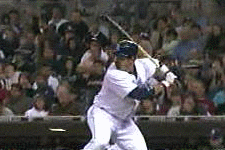
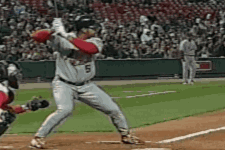
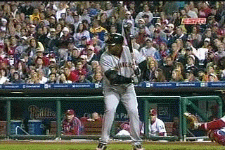
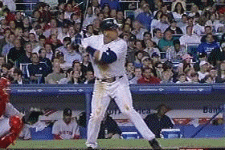
These barrels are launched DOWNWARD. Rearward and downward. They are not flattened then turned upward....with the 'turn upward' being the launch. All the pros swing down. All the mindless on the internet HATE to read that. Epstein and Williams really made a mistake when they started the 'match the plane of the pitch' nonsense. I haven't been around long enough to know if they were the first....but I believe they were....and what they have created, to get rid of the swing down and stay down swings, are two move swings. They criticize the swing down swings that stay down....and teach an up swing. And in the process they create the two move swing....the flatten then swing....the slot then swing swings....that the Lubanski's and Hamilton's (pros who invested heavily in Epstein's teaching) quickly learn has no chance at high levels. When you are taught to swing up at a 10-15 degree angle....you have to flatten/slot first....so you can swing up....and you end up bleeding the corner THEN swinging up instead of down like Bonds/Manny/Pujols/all the greats from behind the corner. The flatten then swing swing is a LONG swing. When Bonds or Pujols talk about a direct line to the ball....straight down to the ball....that is EXACTLY what they do. They TURN the barrel down....rearward and down. The barrel is swung 'about the hands'....around the hands. When it gets to the bottom of the arc it, the barrel, TURNS upward. But the hitter swung down.
The flail part of the swing....IS THE SWING.
To discourage 'swinging down' when in fact all the greats swing down....and swing down on almost every pitch (high pitch is the exception) is hitting malpractice.
Comment
-
Triangle is in these clipsOriginally posted by Teacherman View PostThese clips also show a step by step approach which you can see in action with this college age player.
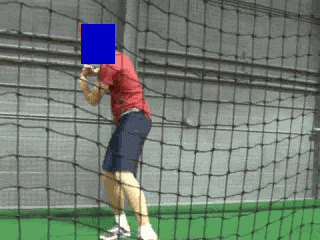
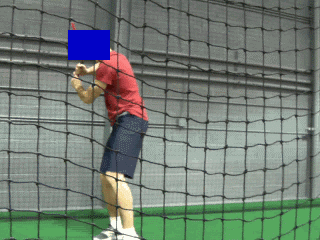
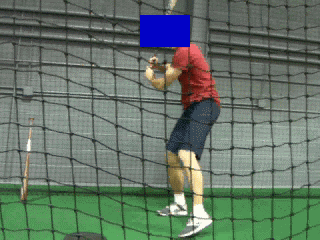
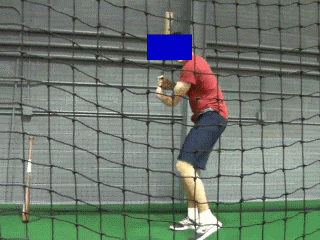
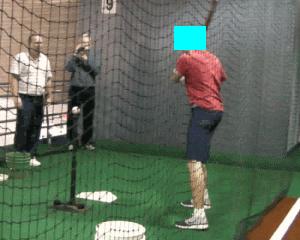
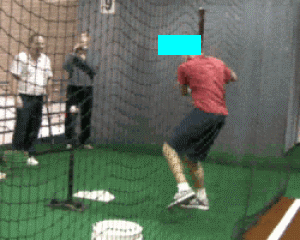
Pay attention to the details of the movements in each clip. Details are HUGE.
What are the hands doing?
What are the forearms doing?
What is the barrel doing?
What are the elbows doing?
What is the torso doing?
Where does the barrel get up to speed?
What is the torso's relationship to the rear leg?
How does this feel in the rear hip socket?
What is the arms relationship to the torso?
Where is the weight distributed?
When does it shift from rear leg to front?
Are you sure?
How do you verify?
By swinging to duplicate.
To list a few questions to guide your study.
There are more.
Comment

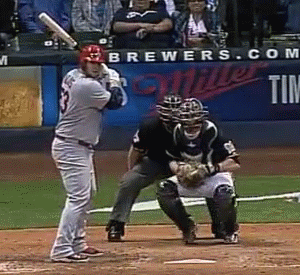
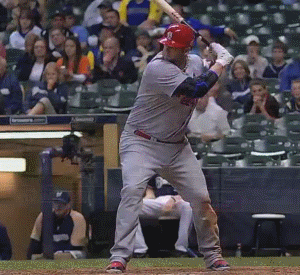
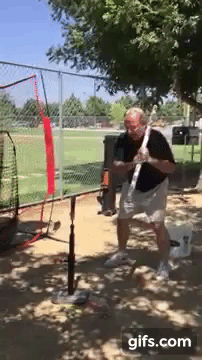 ]
]
Comment